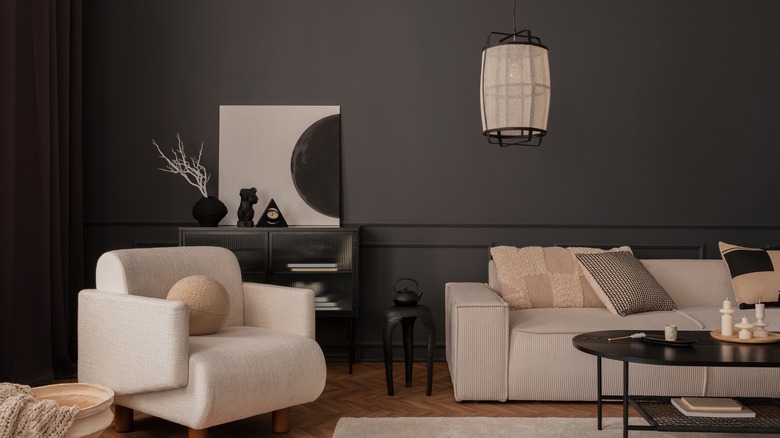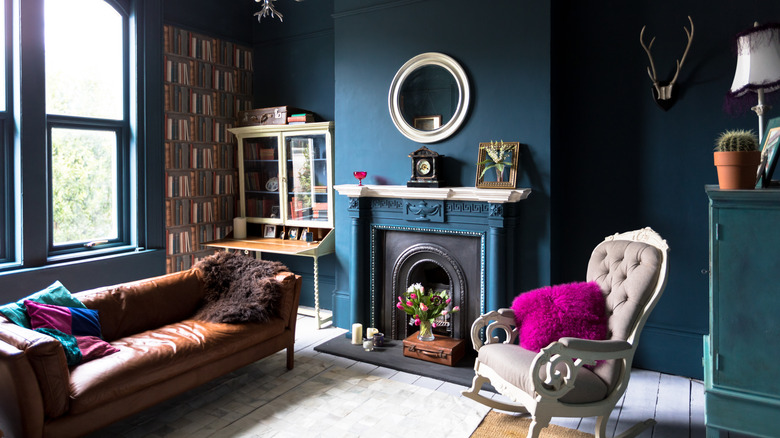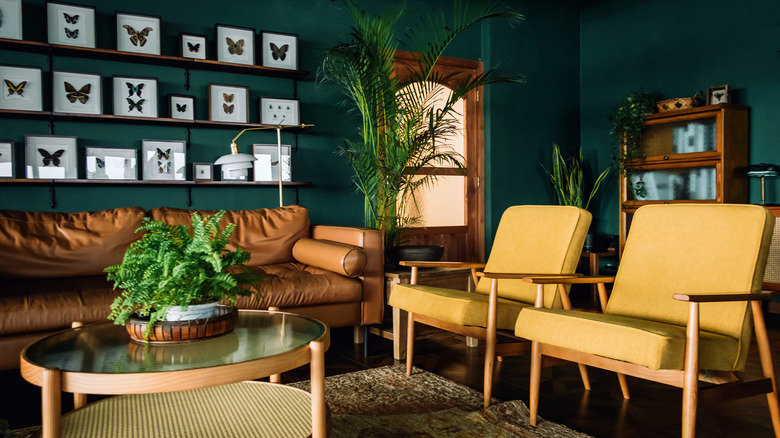Our Design Expert's Tips For Updating Your Living Room To Moody, Not Gloomy
As an interior designer, I have noticed a major shift lately away from design styles like modern farmhouse and neutral boho, as many homeowners (and designers) feel that bland white-on-white and beige-on-beige interiors have seen their day. Instead, homemakers are becoming more open to showcasing bolder and deeper colors in their homes. While some have gravitated toward happy, colorful spaces (like the fun dopamine décor trend) as they move away from all-neutral palettes, others are embracing moody vibes featuring dark tones on the walls and throughout the space. Giving off both a sophisticated and cozy feeling all at once, it's no wonder so many people are opting for this dramatic aesthetic, especially in heavily-utilized spaces like living or family rooms.
For those used to light, neutral spaces, dark hues are nothing to be afraid of! As long as you choose the paint shade carefully, as well as use other colors, materials, and textures to create contrast, the space will feel balanced and never overwhelming. If you're worried about creating an oppressive, cave-like situation, you can also leverage the power of strategic lighting to add extra depth, warmth, ambiance, and coziness. For instance, picture lights can make art pop and stroke walls in soft light, while LED strips can make cabinets glow invitingly. Beyond lighting, here are some surefire tips to ensure your moody living room has all the drama without any of the gloom.
Setting the mood with the perfect paint hue
To create a moody living room, begin with the wall color, as it has a massive impact on the overall look. This aesthetic works best with deep earthy hues with plenty of gray in the paint mix to tone down saturation and make it feel timeless, such as an aged blue-gray, deep brown-gray/taupe, dark sage, forest green, or classic charcoal. If you are feeling bolder, try slightly more saturated colors like a rich eggplant or dark mustard, or dare to paint the walls an elegant black for a real statement (my personal favorite is Tricorn Black by Sherwin-Williams). Be careful not to go too medium-toned with the paint color — keep it dark to avoid looking muddy or like a half measure. I also highly recommend painting the trim the same color as the walls to make the aesthetic work best, as the commitment helps pull off the look and feels upscale. Or take your moody vibes to the max by color-drenching your room, painting the walls, trim, and ceiling in your moody hue.
I also love applying a textured finish to dark walls, such as limewash, Venetian plaster, or Roman clay. Not only do these create a high-end look with a ton of visual interest, but they also add a sense of history, age, and refinement to your space. Alternatively, dark walls with applied picture moldings also look stunning and will further elevate the moody vibes of your living room.
Finishing touches for a moody, not gloomy, living room
Once you have your wall color selected, the trick to making a room feel moody rather than gloomy is balance and contrast. Since we have dark walls, bring in plenty of other colors, textures, and materials to pop against the stormy backdrop. Even when pulling off a dark monochromatic color-drenched look, contrast in materials and textures is still necessary to a degree to allow for harmony and cohesiveness in the space. Mix in rich wood tones, metals (black and antique gold are wonderful with deep hues), natural stone, marble, plaster, concrete, and other materials with a variety of textures to create a sophisticated palette and avoid having the space feel drab or overwhelmingly gloomy. Build a color palette that introduces a bit of respite from the wall color, adding in layers of neutrals or showcasing some color, which will look like a dream against the deep walls.
A finishing touch I love to use in a moody space is a dramatic floor-to-ceiling drapery to double-down on the vibes, opting for something monochromatic with the walls or a complementary deep hue (no light, airy white drapes in this space). It creates luxurious softness and a textural contrast to the walls, while still reinforcing the high-end aesthetic. Finally, add in some greenery to stand out against the dark walls, bringing the space to life and avoiding gloominess with some natural vibrancy.


